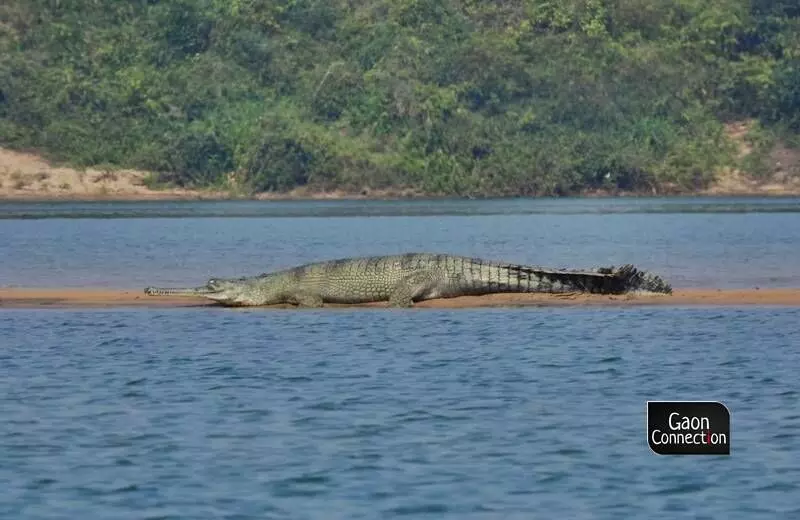Good news on gharial conservation from Satkosia wildlife sanctuary in Odisha
Gharial is a long beaked crocodilian living exclusively on fish. It is found in the Himalayan fed river systems with its southernmost distribution in the river Mahanadi and its tributaries. It is not a danger to human beings but salt-water crocodiles are man eaters and many gullible persons wrongly equate gharials with salt-water crocodiles as a result of which, the lives of the gharials are now in danger.
 Ashis Senapati 20 May 2022 7:19 AM GMT
Ashis Senapati 20 May 2022 7:19 AM GMT

Gharials are not a danger to human beings. But salt-water crocodiles are man eaters. Many gullible persons wrongly equate gharials with salt-water crocodiles as a result the lives of the gharials are now in danger. All photos by Sudrashan Maharana
There is a sense of jubilation along herpetologists and environmentalists in Odisha as the four-decades long project on breeding of gharial (Gavialis gangeticus), a critically endangered crocodile species, in their natural habitat is bearing fruits.
For the second successive year, last week on May 11, around 32 hatchlings were born in the river Mahanadi within Odisha's Satkosia wildlife sanctuary of Angul district.
"After four decades of the launch of the Gharial conservation project in Odisha, last year on May 22, around 21 hatchlings were born in their natural habitat in the Mahanadi river within the 'No Fishing Zone' of the fabled Satkoshia Gorge," Sudarsan Maharana, Gharial Project Advisor and a noted herpetologist, told Gaon Connection. Maharana was also involved in first ever breeding of gharials in captivity in the country at Nandankanan Biological Park in Odisha in 1980s.
"A repetition of natural breeding this year occurred on May 11 with 32 hatchlings born from the eggshells from the same mother at the same nesting site. The natural breeding of gharials in Satkosia is a good sign for gharial conservation in the country," Maharana added.
Also Read: Cyclone Asani Impact: Thousands of nests of the endangered Olive Ridley washed away
For the second successive year, last week on May 11, around 32 hatchlings were born in the river Mahanadi within Odisha's Satkosia wildlife sanctuary of Angul district.
"Gharials are swept away by river currents, mainly by floods in the rainy season, and this makes their conservation all the more challenging. The presence of gharials in the Mahanadi river will promote tourism in Satkosia sanctuary," said Saroj Kumar Panda, Divisional Forest Officer of Satkosia Wildlife Sanctuary, told Gaon Connection.
Gharials in danger
Way back in 1974, a survey found only five gharials (two male and three female) in the southernmost home range of gharials in the river Mahanadi. Since critically endangered, State Forest Department initiated Crocodile Conservation Project in 1975 with an objective to conserve the crocodile species by hatching its eggs and releasing them in the rivers when they grow up to two meters in length.
Further, it was planned to hatch eggs collected from outside at a Rearing Centre at Tikarpada and breeding in captivity at Captive Breeding Centre at Nandankanan Zoological Park. The first captive breeding of gharials in the world occurred in 1980 at Nandankanan and a total of 867 baby gharials had been released during the period from 1977 to 2016, of which one-third from Tikarpada and two-thirds from Nandankanan Zoological Park.
Also Read: Odisha records 33% rise in dolphin population but numbers drop in Chilika lake
At 12 gharials, the survival rate of gharials was found to be alarmingly low in the census of 2017, said Maharana.
New strategy to save gharials
A new strategy for saving the gharial was initiated in 2019 titled 'Species Recovery of Gharial in the River Mahanadi'. It has restructured conservation efforts like the release of large gharials instead of smaller ones who wandered or swept away in flood; involvement of 11 forest divisions on either side of Mahanadi for strict implementation of conservation measures; declaration of a 'No Fishing Zone'; reward for the gharial caught in the net and compensations for the net, massive public awareness for people's participation, the herpetologist added.
Way back in 1974, a survey found only five gharials (two male and three female) in the southernmost home range of gharials in the river Mahanadi.
This resulted in conducive conditions for revival of the natural breeding. And after 40 years, on May 22 last year, around 21 hatchlings were born in the No Fishing Zone of the fabled Satkoshia Gorge in the Mahanadi. "As we have failed to rehabilitate reared gharials in captivity, the mother was entrusted with the rearing of her 28 hatchlings last year. Heavy floods swept away some hatchlings and three were retrieved from fishing nets downstream in 2021," informed Maharana.
A repetition of natural breeding occurred this year on May 11 with 32 hatchlings from the same mother at the same nesting site. "It is heartening to note that the Species Recovery Project has justified the title with survival of gharials getting a major fillip," added Moharana.
Gharial is a long beaked crocodilian living exclusively on fish. It is found in the Himalayan fed river systems with its southernmost distribution in the river Mahanadi and its tributaries. "Gharials are not a danger to human beings. But salt-water crocodiles are man eaters. Many gullible persons wrongly equate gharials with salt-water crocodiles as a result the lives of the gharials are now in danger," said Mihir Patnaik, former Deputy Conservator of Forest, Government of Odisha.
ghariyal #wildlife #Odisha Mahanadi #story
More Stories




